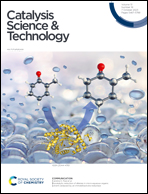CdS/TiO2 nanostructures synthesized via the SILAR method for enhanced photocatalytic glucose conversion and simultaneous hydrogen production under UV and simulated solar irradiation†
Abstract
TiO2 nanoparticles (NPs) and TiO2 nanotubes (NTs) were successfully modified with CdS using the successive ionic layer adsorption and reaction (SILAR) method. The optical properties and size of the CdS/TiO2 nanostructure could be controlled by changing the number of SILAR cycles. Photocatalytic glucose upgrading was carried out in an aerated and unaerated aqueous solution under UV irradiation and simulated solar light. Both systems presented similar main products in an aqueous solution which included gluconic acid, arabinose, xylitol, and formic acid. Compared with TiO2 NPs under the unaerated system, 1CdS/TiO2 NTs enhanced the photocatalytic performance for glucose conversion and hydrogen production under both UV and simulated solar light. The values for glucose conversion and product yields in the aerated system exhibited the same behavior as observed in the unaerated system. This result was explained by two reasons: (1) nanotubes have a high specific surface area which indicates more active sites and leads to better dispersion of CdS on the TiO2 surface, and (2) the CdS/TiO2 heterojunction helps to reduce recombination of electrons and holes by facilitating their spatial separation.



 Please wait while we load your content...
Please wait while we load your content...